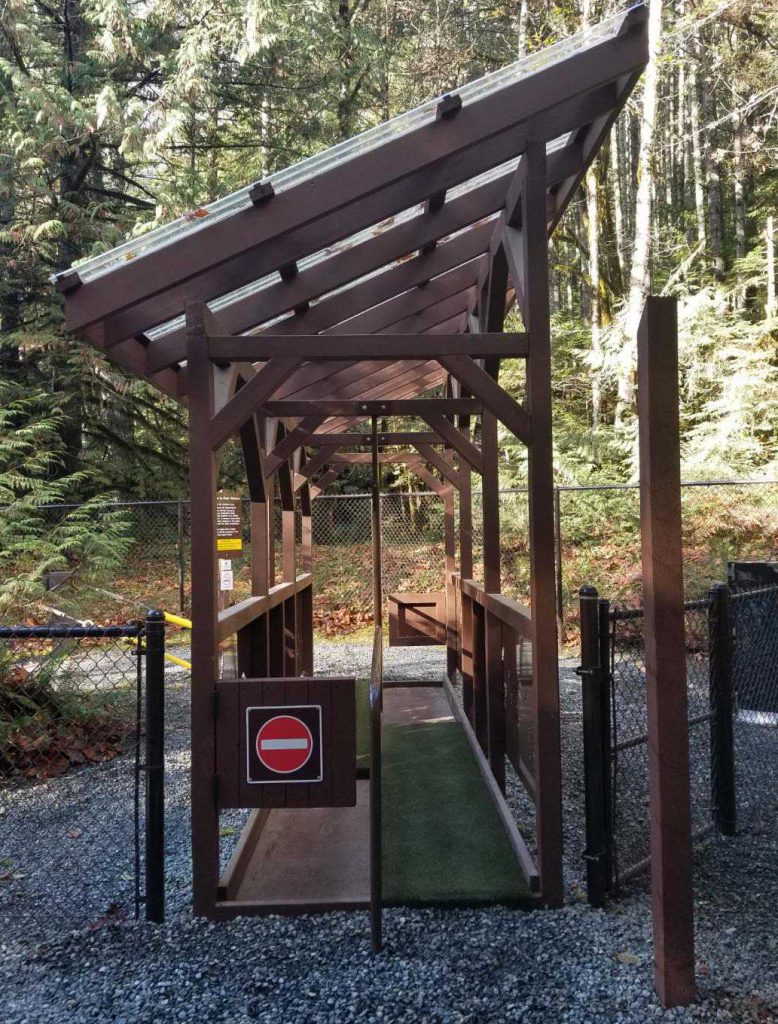Biocleaning station installed at Horne Lake Caves Provincial Park
Categories:

To protect bats against the spread of the deadly White Nose Syndrome (WNS), BC Parks has installed a biocleaning station at Horne Lake Caves Provincial Park.
Believed to be the first of its kind in Canada, the biocleaning station helps remove fungal spores from the virus that causes WNS. Visitors walk along an astroturf mat to scrub dirt off their shoes, then step into a diluted woolite detergent/water solution, followed by a water rinse before entering the caves. The same cleaning process is applied when leaving the area.
According to BC Parks Conservation Specialist Erica McClaren, Horne Lake Caves Provincial Park was selected for the station due to the 60,000-plus visitors that pass through the caves each year. WNS has not been detected in B.C., but it was found in Washington State in 2015, prompting officials here to be prepared.
“The risk of WNS spreading into B.C. is very high. I think it’s just matter of time so we should do everything possible to reduce the risk of it spreading among bat populations,” said McClaren. “While we are not absolutely certain that the biocleaning station will prevent the spread of WNS, because it can spread from bat to bat contact as well, we believe this will help reduce the risk and will also provide an educational experience about WNS and bats for park visitors.”
The deadly fungus grows on the noses and bodies of bats, and can be devastating to affected colonies with mortality rates of 80% to 100%. So far, the disease has killed more than six million bats since arriving in the eastern United States in 2006 and reaching Canada in 2010. Steep bat population declines in eastern North America resulted in an emergency listing of Little Brown and Northern Bats under the federal Species at Risk Act in 2014.

Researchers believe humans have accelerated the spread of the disease by entering caves with contaminated clothing, gear or equipment. As a result, protocols have been developed for decontaminating clothing and equipment that have been used in high-risk environments such as caves, mines, or other bat habitats.
“BC Parks wants to do the right thing and be proactive at reducing the risk of WNS being introduced to and spread from cave parks,” said McClaren, who’s learned a lot from Mammoth Cave National Park in Kentucky, which has been using the biocleaning stations for years. “We followed their general biocleaning station design and standard operating procedures with some adaptations for the Horne Lake Cave park environment.”
The biocleaning station is slated to open next month and is funded through proceeds from the BC Parks Licence Plate Program, which has now generated $2.3 million towards protecting and preserving provincial parks.
Other bat projects supported through licence plate proceeds include a bat-friendly gate at Cody Caves Provincial Park that lets bats fly in and out, but prevents people from entering. A bat monitoring program has also been established across the province, in partnership with other organizations, to help learn more about bat populations.
To learn more about WNS visit: https://www2.gov.bc.ca/gov/content/environment/plants-animals-ecosystems/wildlife/wildlife-health/wildlife-diseases/white-nose-syndrome
To learn more about projects funded by BC Parks specialty licence plates visit http://www.bcparksplates.ca.




